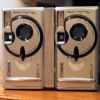|
|
I have included file sizes in the image links. Please take a moment to check these sizes before you begin downloading images for viewing. Several of the JPS files are very large and will be painful to download over a modem link. The images are presented in cross-eye
and anaglyph format. If you prefer a different format or size, please give
the Stereoscope applet a try. |
|
|
|
|
[ Up ] [ A5 Story ] [ A100 Story ] [ A200 Story ]
Why bother with a twin?
 With a slide board and a single camera, you
can create stereo pairs. This is ok for still-lifes, but any motion
between the two exposures leads to flickering in the final images. With
the long cycle times of digitals, flicker from moving leaves, birds, mice, and
people is very likely. The solution is to capture both images at the same
instant.
With a slide board and a single camera, you
can create stereo pairs. This is ok for still-lifes, but any motion
between the two exposures leads to flickering in the final images. With
the long cycle times of digitals, flicker from moving leaves, birds, mice, and
people is very likely. The solution is to capture both images at the same
instant.
Capturing two images at the same instant requires two shutters, two apertures, two lenses, and two "film planes". In the film world, stereo cameras have been made for years, and there are many models from which to choose. Unfortunately, there are not yet any digital stereo cameras on the market. If you want a digital stereo camera, you will have to build it yourself. Inspired by notes I've found for twin Olympus XA, a Kodak DC-20 twin built by David Grenewetzki, a DC-20 based stereo camera by David Burder, and (later) a Kodak DC3800 twin built by Masayuki Iwata, I chose to "twin" a pair of cameras rather than trying to build an honest-to-goodness stereo camera. Using one controller to perform focusing, metering, and shutter control would result in the best possible images. It's much easier to grab a couple of still digital cameras and fire them at the same time. If they are both the same cameras, their metering and white balance should come out fairly close to the same.
What camera to use
| For my first twins, I chose to use a pair of Canon A5 compact digitals. The A5 was introduced in 1998 and operates at resolutions of either 1024x768 or 512x384. | For my second twin, I chose to use a pair of Canon A100 compact digitals. The A100 was introduced in 2002 and operates at resolutions of 1280x960, 1024x768 or 640x480. | For my third twin, I moved up to a pair of Canon A200 compact digitals. The A200 was introduced later in 2002 and operates at resolutions of 1600x1280, 1024x768 or 640x480. | ||||
| Built late in 2000 - In retirement | Built 7/02 - Lost or stolen | Built 10/02 - In use | ||||
| The twin A5 story | The twin A100 story | The twin A200 story | ||||
|
A5 Version 1.1
|
A100 Version 0.9
|
|
||||
|
A5 Version 2.0
|
A100 Version 1.0
|
|||||
|
A5 Version 2.1 Version 2.0 with the following additions:
|
I no longer have my twin A100. I accidentally left
it in the trunk of a rental car in Burlington Vermont. By the time I
called back (three hours later) the car had gone back out and the camera
was never seen again.
If you see my twin somewhere, please let me know. I miss it. |


